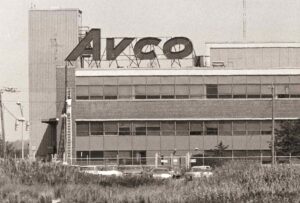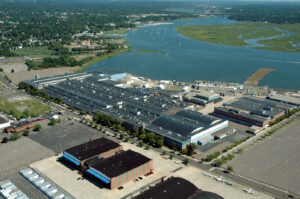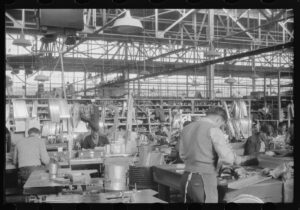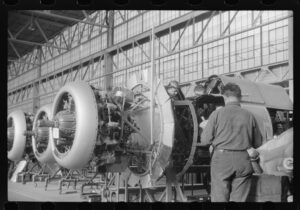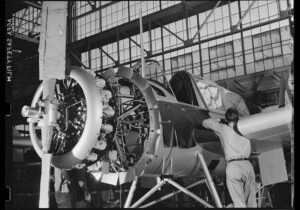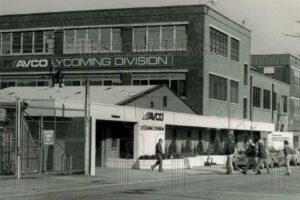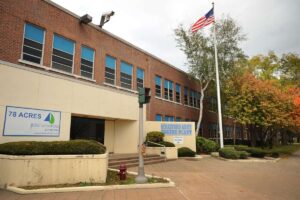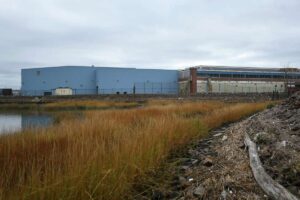STRATFORD ARMY ENGINE PLANT SITE HISTORY
Beginnings: 1929-1951
Prior to 1927, the location of Stratford Army Engine Plant (SAEP) was mainly farmland. The facility was constructed in 1929 as the manufacturing facility of Sikorsky Aero Engineering Corporation. Sikorsky manufactured various amphibious aircraft at this facility, which had a seaplane ramp for launching aircraft into the Housatonic River. With the growing popularity of land-based aircraft in the 1930s, sales of amphibious aircraft fell. In 1938, Sikorsky merged with the Chance Vought Company. The Vought-Sikorsky company used the facility to build various land-based aircraft, such as the Vought-Sikorsky VS-44 and F4U Corsair.
In January 1943, the two companies separated into Vought Aircraft and Sikorsky Aircraft, though Vought Aircraft continued to manufacture various aircraft at the facility. Sikorsky Aircraft moved some of its production to Bridgeport, Connecticut at this time, while Vought Aircraft moved to a production facility in Dallas, Texas in 1949. By 1954, Sikorsky Aircraft had moved the remainder of its manufacturing to a new facility on the north side of Stratford, further up the Housatonic River. This move left the Stratford facility vacant. Soon after, flooding from the river damaged much of the facility. The U.S. Air Force purchased the facility in 1951 and renamed it Air Force Plant No. 43. The Lycoming division of Avco Corporation (Avco-Lycoming) was contracted to operate the facility as a Government-Owned, Contractor-Operated (GOCO) plant. Avco-Lycoming immediately repaired the flood damage and began manufacturing of the R-1820 radial engine and major components of the J-47 jet engine aircraft.
Avco-Lycoming Operations: 1951-1995
In 1952, the U.S. government awarded a contract to Avco-Lycoming to develop the first American gas turbine engine for use in helicopters, resulting in the T53 and T55 series engines. In the 1960s, Avco-Lycoming engineers designed and ALF502 turbofan engines, T-55 engines adapted for cargo helicopters, engines for amphibious hydrofoils, AGT 1500 vehicular turbine engines, and gas turbines for the first commercially-powered hovercraft in the United States. In addition, Avco-Lycoming developed re-entry vehicles for the Titan and Minuteman intercontinental ballistic missile systems. By 1968, Avco Corporation employed nearly 10,000 people at the facility.
In 1976, the facility was transferred from the U.S. Air Force to the U.S. Army and was renamed SAEP. At this time, Avco Corporation’s AGT 1500 engine was selected to power the U.S. Army’s new M1 Abrams main battle tank. The same year, Avco-Lycoming introduced the Super TF series of marine and industrial engines. These engines powered ferry boats, air cushion vehicles, landing craft, and coastal patrol boats. Industrial applications for these engines included compressor sets, pump sets, generator sets, and railroad engines. By 1980, Avco-Lycoming moved production of several turbine engines to a facility in Williamsport, Pennsylvania. In 1987, Avco Corporation (including the Lycoming division) was purchased by Textron, Inc. In 1995, AlliedSignal acquired the Lycoming Turbine Engine Division in Stratford. By this time, employment at SAEP had fallen to approximately 2,900 people.
CLOSURE
In late 1995, AlliedSignal announced that all production at SAEP would be shifted to its facility in Phoenix, Arizona. In September 1998, the company ended operations at SAEP and returned it to the U.S. Army. SAEP was designated for closure by the 1995 Base Realignment and Closure (BRAC) Commission, and the facility was formally closed on September 30, 1998. Afterwards, the U.S. Army shifted production of the AGT 1500 engine to the Anniston Army Depot in Anniston, Alabama.
Over the next decade, the U.S. Army attempted to develop the property. In May 2008, the U.S. Army auctioned off the property for approximately $9.6 million, but the winning bidder never paid. The U.S. Army is currently working with the Connecticut Department of Energy and Environmental Protection (CTDEEP) on the remediation of the nearby tidal flats and has negotiated the sale of the property with a group called Point Stratford Renewal LLC. Additionally, the Connecticut Air and Space Center currently occupies part of the site.
As part of the BRAC process, the U.S. Army is required to identify and document the environmental liabilities associated with the disposal of property at the SAEP site. The records provided on this website represent actions and research completed in relation to this process at the SAEP site.
BRAC ENVIRONMENTAL CLEANUP STATUS
SAEP is a Resource Conservation and Recovery Act site with environmental remediation ongoing since 1983. The primary contaminants of concern are volatile organic compounds and metals in groundwater and soils. Groundwater at the property is not used as a drinking water source. All but four of the environmental cleanup sites have achieved Response Complete status. The remaining ongoing cleanup actions include hazardous waste cleanup at various sites including groundwater remediation, long-term management requirements including five-year reviews, and various compliance cleanup activities. A Covenant Deferral Request by the U.S. Army for the SAEP property was approved in October 2008 by the Governor of Connecticut. This enables the sale and transfer of property before environmental cleanup is complete. In 2014, the U.S. Army performed 56 sediment toxicity tests to evaluate the potential toxicity of sediments from the tidal flats. The results of the toxicity testing indicate that the tidal flats in their entirety may need to be remediated to an average depth of one foot, with some areas up to eight feet.
Additional information regarding the progress of environmental cleanup and land conveyances can be found in the records contained on this website as well as the U.S. Army BRAC Division’s October 2020 Conveyance Progress Report.
ADDITIONAL PHOTOS AND RESOURCES
Additional information about the history of SAEP can be found in the two resources below. To download these resources, click on the respective links.
- Historic Properties Report: Stratford Army Engine Plant, Connecticut. Building Technology, Inc. for the Historic American Engineering Record, National Park Service. 1984. Click here to download.
- Legacy Base Realignment and Closure Installations Conveyance Progress Reports. U.S. Army Office of the Deputy Chief of Staff, G-9. 2020. Click here to download.

